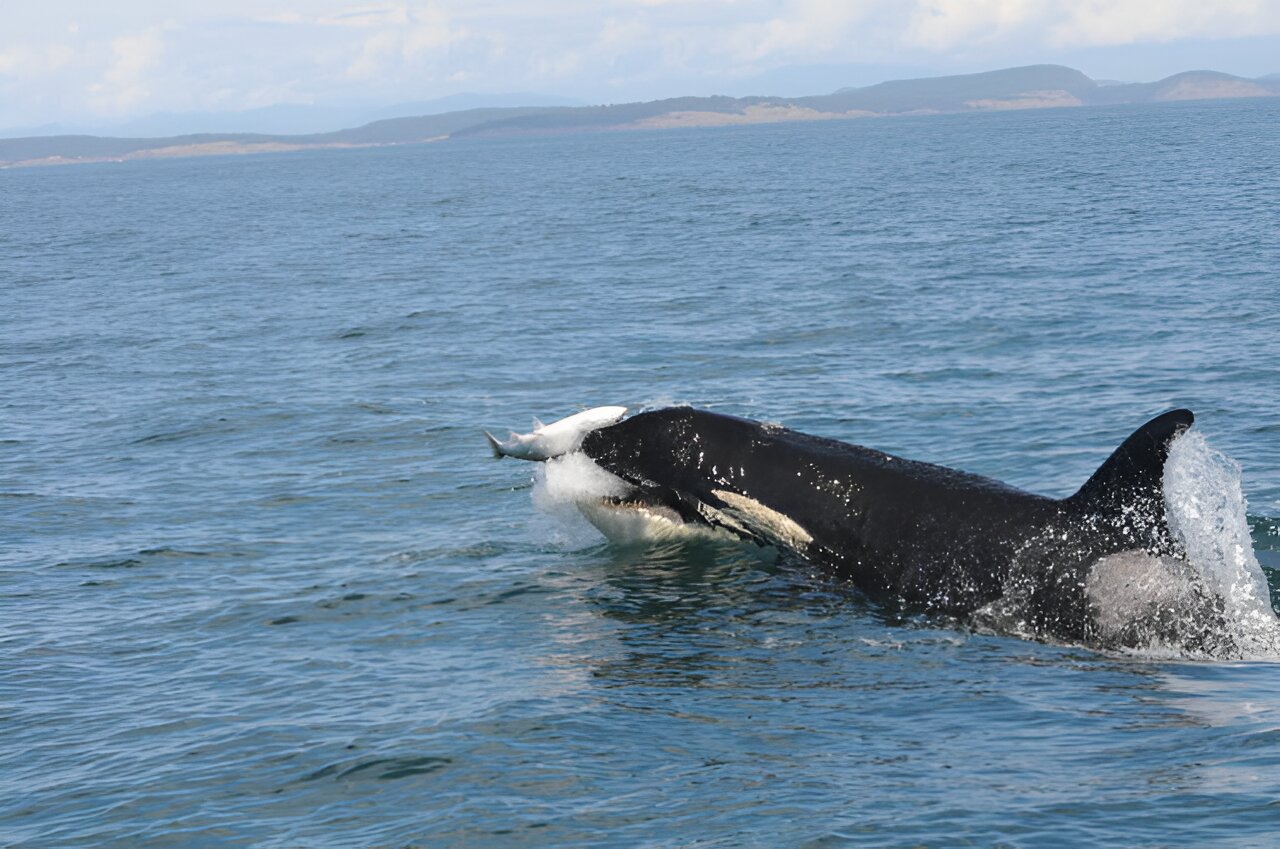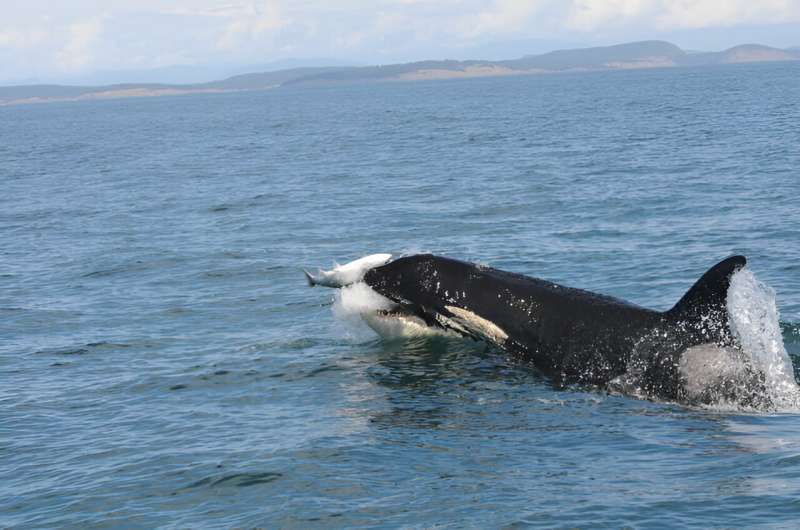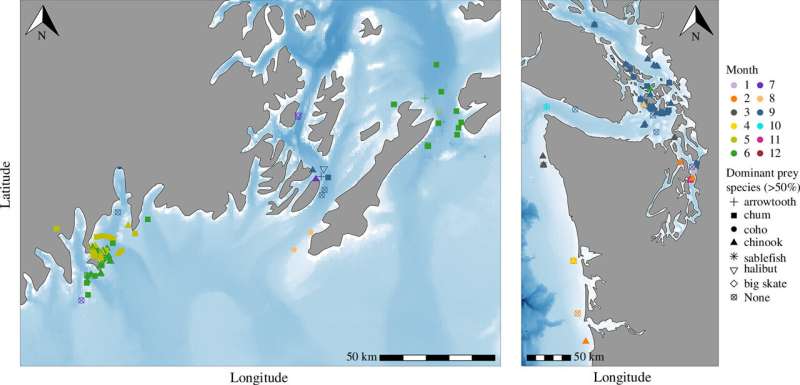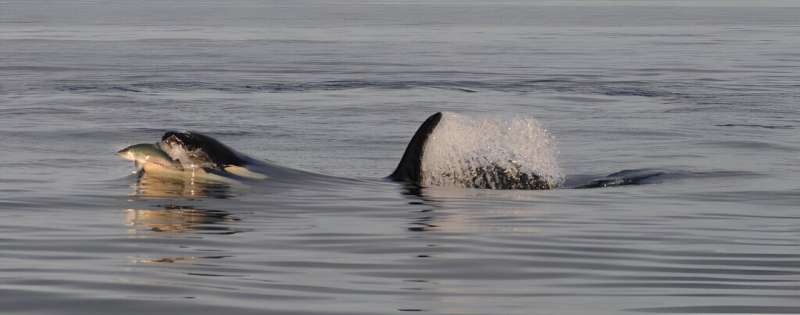

A team led by researchers at the University of Washington and the National Oceanic and Atmospheric Administration has uncovered key information about what resident killer whale populations are eating. Researchers had long known that resident killer whales—also known as resident orcas—prefer to hunt fish, particularly salmon. But some populations thrive, while others have struggled. Scientists have long sought to understand the role that diet plays in these divergent fates.
“Killer whales are incredibly intelligent, and learn foraging strategies from their matriarchs, who know where to find the richest prey resources in their regions,” said Amy Van Cise, UW assistant professor of aquatic and fishery sciences, who began this study as a postdoctoral researcher with NOAA’s Northwest Fisheries Science Center. “So we wanted to know: Does all of that social learning affect diet preferences in different populations of resident killer whales, or in pods within populations?”
In a paper published in the journal Royal Society Open Science, Van Cise and her colleagues report the cuisine preferences of two resident killer whale populations: the Alaska residents and the southern residents, which reside primarily in the Salish Sea and off the coast of Washington, Oregon and northern California.
The two populations show broad preference for salmon, particularly Chinook, chum and coho. But they differ in when they switch to hunting and eating different salmon species, as well as the other fish species they pursue to supplement their diets.
Southern resident killer whales are critically endangered, while other populations are growing. This new study will inform conservation efforts for resident killer whales from northern California to the Gulf of Alaska.

“We know that lack of food is one of the main threats facing the endangered southern resident killer whales,” said Van Cise. “We figured that if we could compare their diet to the dietary habits of a healthy and growing population, it might help us better understand how we can steward and protect this vulnerable population.”
While the rivers of Alaska, British Columbia and the Pacific Northwest have historically provided resident killer whales with abundant levels of salmon, humans have recently disrupted this food supply—both directly by polluting waters and building dams that reduce salmon runs, and indirectly by generating noise pollution that interferes with hunting.
In addition, in the latter half of the 20th century, resident killer whales—particularly southern residents—were captured and penned in amusement parks, which disrupted their social structure and further reduced their numbers.
This anthropogenic impact has left its mark. While Alaska resident killer whales number in the thousands and the northern resident killer whale population is growing steadily, southern resident killer whale numbers have plateaued at approximately 75 individuals. Recent research has implicated noise pollution from cargo vessels and higher rates of pregnancy failure as factors.
For this study, the team from 2011 to 2021 collected fecal samples from both southern resident and Alaska resident killer whales at various points during the year. The researchers analyzed DNA in the fecal samples to determine what the killer whales were eating. They discovered that the summer diet of Alaska residents included more chum and coho salmon, in contrast to the Chinook-heavy summer diet of a southern resident killer whale.

“Chinook are clearly an important resource for resident killer whales in any population. They’re large and energy-rich, which makes them a delicious and nutritious meal,” said Van Cise. “But what we’ve learned from the Alaska residents is that stable sources of other fishes—chum and coho salmon, even flatfishes like arrowtooth flounder—may be an important nutritional supplement helping this population thrive.”
In recent years the team has obtained more fecal samples outside of the summer months. Those samples revealed an unexpectedly diverse diet for resident killer whales. Sablefish, arrowtooth flounder, lingcod, Pacific halibut and big skate all feature in the diets of these whales, which were previously thought to eat salmon exclusively.
The two populations differ in the non-salmon species they choose to supplement their diet, and when they switch among species. These dietary patterns reflect a delicate balance between regional abundance of different fish species, as well as a matriarch’s knowledge of reliable foraging locations.
“The survival of her family depends on whether the foraging sites she knows are reliable from year to year,” said Van Cise.
In both the United States and Canada, resident killer whales have gained fame, particularly the very public plight of southern residents. The team believes that their findings and follow-up dietary studies are key to aiding their recovery.
“While protecting key populations of Chinook salmon will always be vital to supporting the recovery of the endangered southern resident killer whale population, this study has taught us that we might need to think more holistically about how we can conserve the whole ecosystem of fishes that together make up the annual diet of predator populations like this one,” said Van Cise.
More information:
Amy M. Van Cise et al, Spatial and seasonal foraging patterns drive diet differences among north Pacific resident killer whale populations, Royal Society Open Science (2024). DOI: 10.1098/rsos.240445
Provided by
University of Washington
Citation:
Scientists unearth key clues to cuisine of resident killer whale populations (2024, September 19)
retrieved 19 September 2024
from https://phys.org/news/2024-09-scientists-unearth-key-clues-cuisine.html
This document is subject to copyright. Apart from any fair dealing for the purpose of private study or research, no
part may be reproduced without the written permission. The content is provided for information purposes only.